Coastal Douglas-Firs by Great Lakes
reificationofmyth
last year
Featured Answer
Sort by:Oldest
Comments (6)
BillMN-z-2-3-4
last yearbengz6westmd
last yearlast modified: last yearRelated Discussions
one of these Doug Firs is not like the other...
Comments (28)I read with interest this posting with pictures showing curvatures in the trunk of the tree describing it as 'noodle' and 'funky structure'. Could someone explain please how such repeated curves are created? That tree seems to be at least 20 ft tall, and is still doing it. Is it simply weak wood? These are permanent kinks in the stem. I have a 5ft Picea orientalis 'Skylands', 8ft Picea omorika 'Pendula Bruns' and 4ft Pinus contorta 'Taylor's Sunburst' which twist similarly after planting them in 2010 and 2011. Skylands seems to be straightening out, I staked Pendula Bruns. All 3 turned away from the sun the first year, Pendula Bruns is still doing it. Bernd...See MoreHeat Tolerant Conifers 2
Comments (44)cannot speak to heat tolerant conifers sad to say but i thought i would speak up for the surprising adaptability of Mexican conifers (Mexican oaks as well) to seemingly very different climates and localities. i have had gratifying success growing a number of species (likely mostly from areas with a summer rainfall maximum) here in the summer cool and dry (winter very wet) pacific north west (oregon coast)---including pinus montizumae, p. patula, p. pseudostrobus, p. estevezii,, cupressus montana, c. guadalupensis, and podocarpus matudae---.wonderful trees that once established seem to do well with little or no additional care....See Morecomposite deck / bleach mold cleaning recommendations negligent
Comments (10)Yo Ken, if your still around your up on this one. Far as Composites go I am with the Larry/whoever We are for the most part. Composites are really no longer using recycled material because there is just not enough of it so most of the raw stuff is virgin,the energy used to make composite is an enviro no no, when its time to remove the project composite is not real big on bio degrade its tricky to burn shreading it would be silly. Bottom line composites are not so enviro freindly. Info like that might suggest its not all that good to clean it either, with anything. I dont agree>> composites will out last Ipe, left to go silver/gray Ipe is as close to no maintance as a person can get. With the softer composites like Choice/MoistureShield even trex= tjunk I have found a coat or two of TWP 116 seals up the decking,locks in the color and keeps mold,mildew,stains from causing major problems. Of course not needing to do this is the reason the Wallet goes for composite in the first place. I my own self dont like composites at all for the reasons stated in several posts here and on other sites. Welcome aboard Larry!!! Sorry I dident understand your intent at the begining . John...See MoreExtreme Climate Winter Sowing......the HOT zones: 8, 9, and 10 (nati
Comments (0)Salvia lyrata The list below are plants that have all been found growing and thriving in the wild of the most warmest gardening regions. Many have hybrids that have been bred from them...these hybrids generally will be able to also grow in and thrive in the same sub-tropical environment. Please do research them if you're unsure of their hardiness in your particular zone or region, and as always, with any seeds that you're unsure can be winter sown in your region save some seeds to start indoors. Good luck to all! Trudi ================ Abronia fragrans - sand verbena Abronia villosa - desert sand-verbena Acacia angustissima - whiteball acacia Acacia constricta - mescat acacia Acacia farnesiana - sweet acacia Acacia rigidula - chaparro-prieto Acer grandidentatum - bigtooth maple Acer leucoderme - chalk maple Acer negund o- box elder Acer pensylvanicum - striped maple Acer rubrum - red maple Acer saccharinum - silver maple Acer saccharun - sugar maple Achyls triphylla- vanilla leaf Aconitum columbianum - Columbian monkshood Actaea pachypoda - white baneberry Actaea racemosa var. racemosa - black cohosh Actea rubra - red baneberry Aesculus californica - California buckeye Aesculus glabra - Ohio buckeye Aesculus glabra var. arguta - Texas buckeye Aesculus parviflora - bottlebrush buckeye Aesculus pavia var. pavia - red buckeye Agave lechuguilla - lechuguilla Agave parryi - century plant Agave parryi ssp. neomexicana - New mexico agave Agarista populifolia - Florida hobblebush Ageratina altissima var. altissima - white snakeroot Ageratina havanensis - Havana snakeroot Aletris farinosa - white colic root Allium canadens - meadow garlic Allium cernuum - nodding onion Allium stellatum - prairie onion Allium tricoccum - wild leek Allium validum - swamp onion Aloysia gratissima - whitebrush Alnus serrulata - brookside elder Aloysia gratissima - whitebrush Amblyolepsis setigera - honey daisy Amelanchier alnifolia - western serviceberry Amelanchier canadensis - Canadian service-berry Amianthium muscitoxicum - crow poison Amorpha fruticosa - false indigo-bush Ampelopsis arborea - peppervine Amsonia ciliata - fringed bluestar Amsonia tabernaemontana - eastern bluestar Anaphalis margaritacea - pearly-everlasting Andropogon gerardii - big bluestem Andropogon glomeratus - bushy bluestem Andropogen ternarius - split-beard bluestem Andropogen virginicus - broom sedge Anemone canadensis - Canada anemone Anemone caroliniana - Carolina thimbleweed Anemone cylindrica- long-head thimbleweed Anemone multifida - Pacific anemone Anemone quinquefolia - wood anemone Anemone virginiana - tall thimbleweed Anemopsis californica - yerba-mansa Aniscanthus quadrifidus var. wrightii - hummingbird bush Antennaria ssp - pussytoes Antirrhinum multiflorum - multi-flowered snapdragon Aphanostephus skirrhobasis - Arkansas dozedaisy Apocynum androsaemifolium - spreading dogbane Apocynum cannabinum - Indian hemp Aquilegia canadensis - red columbine Aquilegia caerula - Rocky Mountain columbine Aquilegia chrysantha - golden columbine Aquilegia eximia - serpentine columbine Aquilegia flavescens - yellow columbine Aquilegia formosa - scarlet columbine Aralia racemosa - American spikenard Aralia spinosa - devil's walking stick Arbutus menziesii - Pacific madrone Arbutus xalapensis - Texas madrone Arctostaphylos patula - green-leaf manzanita Arctostaphylus uva-ursi - red bearberry Argemone albiflora ssp. texana - white prickly poppy Arisaema draconitum - green dragon Arisaema triphyllum - Jack-in-the-pulpit Armeria maritima - sea thrift Arnica cordifolia - heart-leaf leapardbane Arnica latifolia - daffodil leapardbane Artemisia fililfolia - silver sagebrush Artemisia frigida - prairie sagebrush Aruncus dioicus - goat's beard Aruncus dioicus var. vulgaris - sylvan goat's beard Asarum canadense - Canadian wild ginger Asarum caudatum - long-tail wild ginger Asclepias asperula - antelope horns Asclpias fascicularis - narrow-leaf milkweed Asclepias humistrata - pinewoods milkweed Asclepias incarnata - swamp milkweed Asclepias lanceolata - red milkweed Asclepias speciosa - showy milkweed Asclepias tuberosa - butterfly milkweed Asclepias verticillata - whorled milkweed Asimina triloba - common pawpaw Astagalus canadensis - Canadian milk-vetch Atriplex canescens - four-wing saltbrush Baccharis halimifolia - sea myrtle Baccharis salicifolia - seep willow Bacopa monnieri - water hyssop Bahia absinthifolia - yerba raton Baileya multiradiat a- desert marigold Balsamorrhiza sagittata - arrow-leaf balsamroot Baptisia alba - white wild indigo Baptisia australis - blue wild indigo Baptisia bracteata var. leucophaea - plains wild indigo Bauhinia lunarioides - Texas plume Berlandiera lyrata - lyre-leaf greeneyes Betula nigra - river birch Betula papyrifera - paper birch Bignonia capreolata- crossvine Blephilla ciliata - downy pagoda-plant Borrichia frutescens - bushy seaside-tansy Bouteloua curtipendula - side-oats grama Bouteloua eriopoda - black grama Bouteloua gracilis - blue grama Bouteloua hirsuta - hairy grama Bouvardia ternifolia - firecracker bush Brodiaea elegans - elegant cluster-lily Buchloe dactyloides - buffalo grass Calliandra eriophylla - fairy duster Callicarpa americana - American beauty berry Callirhoe alcaeoides - pink poppy-mallow Callirhoe digitata - finger poppy-mallow Callirhoe involucrata - purple poppy-mallow Callirhoe papaver - woodland poppy-mallow Calochortus albus - fairy lantern Calochortus kennedyi - desert mariposa Calochortus macrocarpus - sagebrush mariposa lily Calochortus monophyllus - yellow-star mariposa lily Calochortus nuttallii - mariposa lily Calochortus uniflorus - monterey mariposa lily Caltha leptosepala - white marsh-marigold Calycanthus floridus - Carolina allspice Calylophus berlandieri - square-bud sundrops Calylophus lavandulifolius - lavender-leaf sundrops Calylophus serrulatus - yellow sundrops Caltha palustris var. palustris - marsh marigold Camassia quamash - small camas Camassia scilloides- Atlantic camas Campanula rotundifolia- bluebell-of-Scotland Campanula scouleri - pale bellflower Campanulastrum americanum - American bellflower Campsis radicans - trumpet vine Cardamine concatenata - cut-leaf toothwort Cardamine diphylla - two-leaved toothwort Carex stipata - stalk-grain sedge Carnegia gigantea - saguaro Carpenteria californica - bush anemone Carpinus caroliniana - American hornbeam Carya alba - mockernut hickory Carya illinoinensis - pecan Carya ovata - shag-bark hickory Castanea pumila - Allegheny Chinkapin Castilleja applegatei ssp. martinii - desert paintbrush Castilleja coccinea - scarlet Indian paintbrush Castilleja foliolosa - Texas chaparral Castilleja indivisa - entire-leaf Indian paintbrush Castilleja integra - squawfeather Castilleja linariifolia - Wyoming Indian paintbrush Castilleja miniata - meadow Indian paintbrush Castilleja parviflora - mountain Indian paintbrush Castilleja rhexiiifolia - rosy Indian paintbrush Castilleja sessiliflora - Great Plains Indian paintbrush Catalpa bignonioides - southern catalpa Caulophyllum thalictoides - blue cohosh Ceanothus americanus - New Jersey tea Ceanothus greggii var. vestitus - desert ceanothus Ceanothus herbaceus - prairie redroot Ceanothus integerrimus - deerbush Ceanothus megacarpus - big-pod buckbrush Ceanothus velutinus - tobacco-brush Celtis laevigata - sugar berry Celtis occidentalis - common hackberry Celtis pallida - desert hackberry Centaurea americana - American basket-flower Cephalanthus occidentalis - common buttonbush Cercis canadensis - redbud Cercis canadensis var. texensis - Texas redbud Cercocarpus montanus - mountain mahogany Chamaecrista fasciculata - partridge pea Chamaecrista nicitans - sensitive pea Chamaelirium luteum - fairywand Chamerion angustifolium ssp. angustifolium - narrow-leaf fireweed Chamerion latifolium - broad-leaf fireweed Chasmanthium latifolium - river oats Chilopsis linearis - desert willow Chionanthus virginicus - white fringetree Chrysactinia mexicana - damianita Chrysogonum virginianum - green-and-gold Chrysopsis mariana - Maryland golden aster Clarkia amoena - farewell-to-spring Clarkia concinna - red ribbons Clarkia unguiculata - mountain garland Claytonia caroliniana - Carolina springbeauty Claytonia lanceolata - lance-leaf springbeauty Claytonia virginica - springbeauty Clematis columbiana - purple virgin's bower Clematis crispa - swamp leather flower Clematis hirsutissima - sugarbowls Clematis pitcheri - purple clematis Clematis texensis - scarlet clematis Clematis virginiana - virgin's bower Cleome isomeris - bladder-pod spider-flower Cleome lutea - yellow beeplant Cleome serrulata - Rocky Mountain beeplant Clethra acumininata - mountain sweet-pepperbush Clethra alnifolia - coastal sweet-pepperbush Clintonia andrewsiana - western bluebead lily Clintonia borealis - yellow bluebead lily Clintonia umbellulata - white bluebead lily Clintonia uniflora - bride's bonnet Cocculus carolinus - Carolina coralbead Collomia linearis - narrow-leaf mountain trumpet Collinsonia canadensis - citronella horsebalm Collinsia heterophyll - Chinese houses Colubrina texensis - Texas snakewood Collomia linearis - narrow-leaf mountain trumpet Commelina dianthifolia - bird-bill dayflower Commelina erecta - white-mouth dayflower Comptonia peregrina - sweet-fern Condalia hookeri - Brazilian bluewood Conoclinum coelestinum - blue mistflower Cooperia drummondii - evening rain-lily Coreopsis auriculata - lobed tickseed Coreopsis calliopsidea - leaf-stem tickseed Coreopsis douglasii - Douglas' tickseed Coreopsis gigenatea - giant tickseed Coreopsis gladiata - coastal tickseed Coreopsis grandiflora - large-flowered tickseed Coreopsis lanceolata - lance-leaved tickseed Coreopsis nudata - swamp coreopsis Coreopsis palmata - stiff coreopsis Coreopsis tinctoria - plains coreopsis Coreopsis tripteris - tall coreopsis Cornus alternifolia - alternate-leaf dogwood Cornus canadensis - Canadian bunchberry Cornus drummondii - rough-leaf dogwood Cornus florida - flowering dogwood Cornus nuttalii - Pacific flowering dogwood Cornus sericea - red-twig dogwood Corydalis sempervirens - pale corydalis Cotinus obovatus - American smoketree Crataegus marshallii - parsley hawthorn Crataegus mollis - downy hawthorn Crataegus opaca - river-flat hawthorn Crataegus phaenopyrum - Washington hawthorn Crinum americanum - swamp lily Cyrilla racemiflora - swamp titi Dalea candida var. candida - white prairie-clover Dalea formosa - featherplume Dalea frutescens - black prairie-clover Dalea greggii - indigo bush Dalea pupurea var. purpurpea - purple prairie-clover Dasiphora fruticosa ssp. floribunda - shrubby cinquefoil Dasylirion ssp. - desert pampas grass Decodon verticillatus - swamp loosestrife Delphinium barbeyi - subalpine larkspur Delphinium cardinale - scarlet larkspur Delphinium carolinianum - Carolina larkspur Delphinium carolinianum ssp. virescens - prairie larspur Delphinium glareosa - Olympic larkspur Delphinium glaucum - tower larkspur Delphinium nudicaule - red larkspur Delphinium nuttallianum - two-lobe larkspur Delphinium parishii - desert larkspur Delphinium scaposum - bare-stem larkspur Delphinium tricome - dwarf larkspur Desmanthus illnoensis - prairie bundle-flower Desmodium canadense - showy tick-trefoil Desmodium illioense - Illinoise tick-trefoil Dicentra canadensis - squirrel corn Dicentra cucullaria - dutchman's breeches Dicentra formosa - Pacific bleedinghearts Dichelostemma capitatum ssp. capitatum - wild hyacinth Diplacus grandiflorus - large-flower bush-monkey-flower Diplacus longiflorus - southern bush-monkey-flower Diplacus puniceus - red bush-monkey-flower Diervilla sessilfolia - southern bush-honeysuckle Dichelostemma capitatum ssp. capitatum - wild hyacinth Dimorphocarpa wislizeni - tourist plant Diospyros texana - Texas persimmon Diospyros virginiana - common persimmon Dodecathon amethystinum - amethyst shooting star Dodecathon clevelandii - Cleveland's shootingstar Dodecathon hendersonii - Henderson's shootingstar Dodecathon jeffreyi - tall mountain shootingstar Dodecathon meadia - shooting star Doellingeria umbellata var. umbellata - flat-top aster Dracopsis amplexicaulis - clasping coneflower Dryas drummondii - yellow dryas Dryas octopetala - white mountain-avens Dudleya cymosa - canyon live-forever Dudleya farinosa - powdery live-forever Dyssodia ssp. - dyssodia Echinacea angustifolia - narrow-leaved purple coneflower Echinacea pallida - pale coneflower Echinacea purpurea - eastern purple coneflower Echinocereus engelmannii - strawberry cactus Echinocereus fendleri - pink-flower hedgehog cactus Echinocereus rigidissimus - rainbow hedgehog cactus Ehretia anacua - sandpaper tree Elymus canadensis - Canada wild rye Empetrum nigrum - black crowberry Encelia farinosa - brittlebush Engelmannia peristenia - Engelmann's daisy Epigaea repens - trailing arbutus Epilobium canum ssp. latifolium - hummingbird trumpet Epilobium obcordatum - rock fringe Epilobium rigidum - Siskiyou rock fringe Ericameria nauseosa ssp. nauseosa var. nauseosa - rabbitbrush Erigeron compositus - dwarf mountain fleabane Erigeron divergens - spreading fleabane Erigeron glaucus - seaside fleabane Erigeron modestus - prairie fleabane Erigeron peregrinus - subalpine fleabane Erigeron puchellus - robin's plantain Erigeron speciosus - showy fleabane Eriogonum compositum - arrow-leaf buckwheat Eriogonum douglasii - Douglas' wild buckwheat Eriogonum inflatum - desert trumpet Eriogonum umbellatum - sulfur-flower buckwheat Eriophyllum confertiflorum - yellow yarrow Eriophyllum lanatum - Oregon sunshine Erodium texanum - Texas stork's-bill Erysimum capitatum - western wallflower Eryngium leavenworthii - Leavenworth's eryngo Eryngium yuccifolium - button snakeroot Erysimum capitatum - sand-dune wallflower Erythrina herbacea - red cardinal Erythronium albidum car. albidum - white trout-lily Erythronium americanum - American trout-lily Erythonium grandiflorum - glacier lily Escholzia caespitosa - tufted poppy Escholzia californica - California poppy Escholzia californica ssp. mexicana - Mexican gold poppy Eucaphalus ledophyllus var. ledophyllus - Cascade wayside-aster Eunonymus americana - Brook eunonymus Eunonymus atropurpea - burning bush Eupatorium fistulosum - joe-pye-weed Eupatorium maculatum - spotted joe-pye-weed Eupatorium occidentale - western thoroughwort Eupatorium odoratum - blue mistflower Eupatorium perfoliatum - common joe-pye-weed Eupatorium purpureu m- sweet scented joe-pye-weed Euphorbia antisyphilitica - wax plant Euphorbia corollata - flowering spurge Euphorbia marginata - snow-on-the-mountain Eurybia macrophyllus - large-leaf wood aster Eurybia sibirica - Siberian wood aster Eustoma exaltatum ssp. russellianum - prairie bluebell Eysenhardtia texana - Texas kidneywood Fagus grandifolia - American beech Fallugia paradoxa - Apache plume Fendlera rupicola - cliff fendlerbush Ferocactus wislizeni - candy barrel cactus Forestiera pubescens var. pubescens - desert olive Fothergilla gardenii - dwarf witch-elder Forestiera pubescens var. pubescens - desert olive Fouquieria splendens - ocotillo Fragaria virginiana - wild strawberry Fragaria virginiana ssp. platypetala - western alpine strawberry Frangula caroliniana - Carolina false buckthorn Fraxinus americana - white ash Fraxinus berlandieriana - Mexican ash Fraxinus latifolia - Oregon ash Fraxinus pennsylvanica - green ash Fraxinus texensis - Texas ash Fremontodendron californicum - California flannelbush Fritillaria affinis var. affinis - mission bells Fritillaria pudica - yellow missionbells Fritillaria recurva - scarlet missionbells Gaillardia aestivalis var. aestivalis - prairie gaillardia Gaillardia aristata - great blanket-flower Gaillardia pinnitafida - yellow gaillardia Gaillardia pulchella - Indian blanket Gaillardia suavis - rayless gaillardia Galium boreale - northern bedstraw Galium triflorum - sweet-scented bedstraw Garrya wrightii - Wright's catclaw Gaultheria procumbens - eastern teaberry Gaultheria shallon - salal Gaura biennis - biennial gaura Gaura coccinea - scarlet gaura Gaura lindheimeri - white gaura Gaylussacia baccata - black huckleberry Gelsemium sempervirens - Carolina jessamine Gentiana calycosa - Rainier pleated gentian Gentiana parryi - Parry's gentian Gentiana saponaria - soapwort gentian Gentianopsis crinita - greater fringed-gentian Geranium carolinianum - Carolina cranesbill Geranium maculatum - wild geranium Geranium viscosissimum - sticky wild geranium Geum rivale - water avens Geum triflorum - purple avens Glandularia bipinnatifida var. bipinnatifida - prairie verbena Gleditsia triacanthos - honey locust Glycyrrhiza lepidota - American licorice Grayia spinosa - spiny hop-sage Gutierrezia sarothrae - broom snakeweed Gymnocladus dioicus - Kentucky coffee-tree Habranthus tubispanthus - Rio Grande copper-lily Halesia diptera - American snowdrop tree Hamamelis virginiana - American witch hazel Hedyotis nigricans - diamond flower Helenium autumnale - fall sneezeweed Helianthus annuus - common sunflower Helianthus debilis - beach sunflower Helianthus giganteus - giant sunflower Helianthus gracilentus - slender sunflower Helianthus pauciflorus ssp. pauciflorus stiff sunflower Helianthus petiolaris - prairie sunflower Helianthus strumosus - woodland sunflower Helianthus tuberosus - Jerusalem artichoke Heliomeris multiflora var. mulitflora - showy false goldeneye Heliopsis helinathoides - ox-eye sunflower Hepatica nobilis var. acuta - sharp-lobed hepatica Hepatica nobilis var. obtusa - round-lobed hepatica Hesperaloe parviflora - red yucca Hesperocallis undulata - desert lily Heterotheca villosa var. villosa - golden aster Heuchera americana - American alumroot Heuchera parvifolia - little-leaf alumroot Heuchera rubescens - mountain alumroot Heuchera villosa - hairy alumroot Hexastylis arifolia var. arifolia - heart-leaf ginger Hexastylis shuttleworthii var. shuttlewrthii - Shuttleworth's ginger Hibiscus coulteri - desert rose-mallow Hibiscus denudatus - rock hibiscus Hibiscus martianus - heart-leaf rose-mallow Hibiscus moscheutos - rose-mallow Hibiscus moscheutos ssp. lasiocarpos - wooly mallow Holodiscus discolor - hillside oceanspray Holodiscus dumosus - glandular oceanspray Houstonia caerulea - bluets Houstonia procumbens - round-leaf bluets Hydrangea arborescens - wild hydrangea Hydrangea querciflia - oak-leaf hydrangea Hydrastis canadensis - goldenseal Hymenocallis caroliniana - Carolina spider-lily Hymenopappus artemisiifolius - old plain's man Hymenoxys hoopesii - orange sneezeweed Hypericum hypericoides ssp. hypercoides - St. Andrew's cross Hypericum prolificum - shrubby St John's-wort Hypoxis hirsuta - eastern yellow star-grass Ilex decidua - deciduous holly Ilex opaca - American holly Ilex verticillata - Michigan holly Ilex vomitoria - Yaupon holly Iliamna rivularis - mountain globemallow Illicium floridanum - Florida anisetree Ipomoea leptophylla - bush morning-glory Ipomopsis aggregata ssp. aggregata - scarlet gilia Jeffersonia diphylla - twinleaf Juglans microcarpa - Texas walnut Juglans nigra - black walnut Justicia californica - hummingbird bush Kallstroemia grandiflora - Arizona poppy Kalmia angustifolia - sheep laurel Kalmia latifolia - mountain laurel Kalmia polifolia - bog laurel Koeleria macrantha - prairie koeler's grass Kosteletzkya virginica - seashore mallow Krascheninnikovia lanata - winterfat Lantana urticoides - trailing lantana Larrea tridentata - creosote bush Lasthenia californica - California goldfields Lathyrus splendens - campo pea Layia glandulosa - white tidytips Layia platyglossa - coastal tidytips Ledum groenlandicum - rusty Labradore tea Leersia orysoides - rice cut grass Lepidium montanum - mountain pepperwort Lesquerella fendleri - Fendler's bladderpod Lesquerella gordonii - Gordon's bladderpod Lesquerella gracilis - spreading bladderpod Leucaena retusa - goldenball leadtree Leucophyllum frutescens - purple sage Leucothoe axillaris - coastal doghobble Leucothoe fontanesiana - highland doghobble Lewisia cotyledon - Siskiyou bitter-root Lewisia rediviva - Oregon bitter-root Liatris aspera - tall gayfeather Liatris elegans - pink-scale gayfeather Liatris mucronata - narrow-leaf gayfeather Liatris punctata - dotted gayfeather Liatris pycnostachya - cattail gayfeather Liatris spicata - dense gayfeather Liatris squarrosa - scaly gayfeather Lilium canadense - Canadian lily Lilium catesbaei - pine lily Lilium columbianum - Oregon lily Lilium humboldtii - Humboldt's tiger lily Lilium michauxii - Carolina lily Lilium michiganense - Michigan lily Lilium pardalinum - tiger lily Lilium parvum - alpine lily Lilium philadephicum - wood lily Linanthus androsaceus - false babystars Linanthus dianthiflorus - fringed desert-trumpets Linanthus grandiflorus - large-flower desert-trumpets Lindera benzoin - northern spicebush Lindheimera texana - Texas yellowstar Linnaea borealis - American twinflower Linum lewisii var. lewisii - blue flax Linum rigidum - large-flower yellow flax Liquidambar styraciflua - sweet gum Liriodendron tulipifera - tulip-tree Lithospermum canescens - hoary puccoon Lithospermum caroliniense - hairy puccoon Lithospermum incisum - fringed puccoon Lobelia cardinalis - Cardinal flower Lobelia glandulosa - glade lobelia Lobelia siphilitica - great blue lobelia Lobelia spicata - pale-spike lobelia Lonicera albiflora - white honeysuckle Lonicera ciliosa - orange honeysuckle Lonicera involucrata - four-line honeysuckle Lonicera sempervirens - coral honeysuckle Luetkea pectinata - partridgefoot Lupinus albifrons - white-leaf bush lupine Lupinus arboreus - yellow-bush lupine Lupinus bicolor - pygmy-leaved lupine Lupinus breweri - Brewer's lupine Lupinus caudatus - Kellog's spurred lupine Lupinus concinnus - Bajada lupine Lupinus croceus - Mount Eddy lupine lupinus densiflorus var. aurea - golden lupine Lupinus havardii - Big Bend bluebonnet Lupinus nanus - ocean-blue lupine Lupinus perennis - wild lupine Lupinus polyphyllus - meadow lupine Lupinus sericeus - Pursh's silky lupine Lupinus subcarnosus - sandyland bluebonnet Lupinus succulentus - arroyo lupine Lupinus texensis - Texas bluebonnet Lupinus versicolor - vari-colored lupine Lysichton americanus - yellow-skunk cabbage Lysimachia ciliata - fringed yellow-loosestrife Machaeranthera tanacetifolia - Tahoka daisy Magnolia ashei - Ashe's magnolia Magnolia grandiflora - southern magnolia Magnolia tripetala - umbrella magnolia Magnolia virginiana - sweet-bay Mahonia aquilfolium - holly-leaf Oregon grape Mahonia repens - creeping Oregon-grape Mahonia trifoliata - Laredo Oregon-grape Maianthemum canadense - Canada mayflower Maianthemum dilatum - two-leaf false Solomon's-seal Maianthemum racemosum ssp. racemosum - false spikenard Maianthemum stellatum - starry false Solomon's-seal Malus ioensis - prairie crabapple Malvaviscus arboreus var. drummondii - turk's-cap mallow Marshallia caespitosa var. caespitosa - Barbara's buttons Marsilea macropoda - big-foot water-clover Maurandella antirrhiniflora - snapdragon vine Melampodium leucanthum - blackfoot daisy Mentzelia laevicaulis - giant blazingstar Mentzelia lindleyi - Lindley's blazingstar Menyanthes trifoliata - buck bean Mertensia ciliata - mountain bluebells Mertensia virginica - Virginia bluebells Mimosa borealis - pink mimosa Mimosa dysocarpa - velvet-pod mimosa Mimosa microphylla - little-leaf mimosa Mimulus bigelovii - yellow-throat monkey-flower Mimulus cardinalis - scarlet monkey-flower Mimulus guttatus - golden monkey-flower Mimulus kelloggii - Kellogg's monkey-flower Mimulus lewisii - great purple monkey-flower Mimulus primuloides - primrose monkey-flower Minuartia obtusiloba - alpine stitchwort Mirabilis multiflora - Colorado four-o-clock Mirabilis multiflora var. pubescens - wild four-o-clock Mitchella repens - partridge berry Mitella diphylla - two-leaf bishop's cap Monarda citriodora - lemon beebalm Monarda didyma - scarlet beebalm Monarda fistulosa - Oswego tea Monardella odoratissima - mountain pennyroyal Morella cerifera - southern bayberry Muhlenbergia capillaris - hairy-awn muhly Myosotis asiatica - Asian forget-me-not Myrica gale - sweetgale Muhlenbergia capillaris - Gulf muhly Muhlenbergia lindheimeri - Lindheimer's muhly Muhlenbergia reverchonii - seep muhly Nemophila maculata - five-spot Nemophila menziesii - Menzie's baby-blue-eyes Nolina erumpens - foothill bear-grass Nolina microcarpa - Sacahuista bear-grass Nolina texana - Texas bear-grass Nothochelone nemorosa - woodland penstemon Nuphar lutea - cow-lily Nuphar lutea ssp. polysepala - pond lily Nympaea odorata - American white water-lily Nyssa slyvatica - black gum Oenothera albicaulis - white-stem evening primrose Oenothera biennis - common evening primrose Oenothera brachycarpa - short-fruit evening primrose Oenothera casepitosa - tufted evening primrose Oenothera cheiranthifolia - beach evening primrose Oenothera deltoides - desert evening primrose Oenothera elata ssp. hookeri - giant evening primrose Oenothera flava - shortfin-evening primrose Oenothera fruiticosa - narrow-leaf evening primrose Oenothera macrocarpa - Missouri evening primrose Oenothera primiveris - yellow-flower desert evening primrose Oenothera rhombipetala - diamond-petal evening primrose Oenothera speciosa - pink evening primrose Oligneuron rigidum var. rigidum - stiff goldenrod Opuntia acanthocarpa - staghorn cholla Opuntia basilaris - beaver-tail cactus Opuntia humifusa - prickly pear Opuntia imbricata - tree cholla Opuntia leptocaulis - desert christmas cactus Opuntia phaeacantha - purple-fruited prickly pear Opuntia polycantha - plains prickly pear Orontium aquaticum - goldenclub Orthocarpus purpurascens - red owl's clover Ostrya viginiana - eastern hop-hornbeam Oxalis oregana - redwood sorrel Oxydendrum arboreum - sourwood Pachysandra procumbens - mountain spurge Packera aurea - golden groundsel Packera cana - silver-woolly groundsel Packera glabella - cress-leaf groundsel Packera obovata - round-leaf groundsel Packera plattensis - prairie groundsel Paeonia californica - California peony Palafoxia callosa - small palafox Panicum virgatum - wand panic grass Parkinsonia florida - blue palo-verde Parthenium incanum - mariola Parthenium integrifolium - wild quinine Parthenocissus quinquefolia - Virginia creeper Passiflora incarnata - purple passion flower Passiflora lutea - yellow passion flower Pavonia lasiopetala - Texas swamp-mallow Pectis angustifolia - lemonscent Pedicularis groenlandicum - bull elephant's head Penstemon albidus - red-line beardtongue Penstemon azureus - sky-blue beardtongue Penstemon ambiguus - pink plains beardtongue Penstemon angustifolius - broad-beard beardtongue Penstemon australis - Eustis Lake beardtongue Penstemon baccharifolius - rock beardtongue Penstemon barbatus - beard-lip beardtongue Penstemon buckleyi - Buckley's beardtongue Penstemon canescens - eastern grey beardtongue Penstemon centranthifolius - scarlet bugler Penstemon cobaea - cobaea beardtongue Penstemon davidsonii - timberline beardtongue Penstemon deustus - hot-rock beardtongue Penstemon digitalis- foxglove beardtongue Penstemon eatonii - firecracker penstemon Penstemon fendleri - Fendler's beardtongue Penstemon fruticosa - shrubby beardtongue Penstemon grandiflorus - large flowered beardtongue Penstemon grinellii var. scrophularioides - Grinnell's penstemon Penstemon heterophyllus - foothill beardtongue Penstemon laetus - western gray beardtongue Penstemon jamesii - James' beardtongue Penstemon multiflorus - many-flower beardtongue Penstemon murrayanus - scarlet beardtongue Penstemon palmeri - scented beardtongue Penstemon parryi - Parry's beardtongue Penstemon pseudospectabilis - rosy desert beardtongue Penstemon rostriflorus - beaked beardtongue Penstemon rupicola - cliff beardtongue Penstemon serrlatus - Cascade beardtongue Penstemon smallii - Small's beardtongue Penstemon spectabilis - showy beardtongue Penstemon strictus - Rocky Montain beardtongue Penstemon triflorus - Heller's beardtongue Petrophyton caespitosum - tufted rockmat Phacelia camanularia - desert bells Phacelia congesta - blue curls Phacelia minor - wild Canterbury bells Phacelia sericea - purplefringe Phacelia tanacetifolia - lacy scorpion-weed Philadelphus californicus - California mock orange Phlox adsurgens - woodland phlox Phlox carolina - Carolina phlox Phlox diffusa - spreading phlox Phlox divaritica - wild blue phlox Phlox divaricata ssp. laphamii - Sweet William Phlox drummondii - Drummond's phlox Phlox longifolia - long-leaf phlox Phlox nana - canyon phlox Phlox pilosa - downy phlox Phlox speciosa ssp. occidentalis - showy phlox Phlox stanysburyi - cold-desert phlox Phlox stolonifera - creeping phlox Phragmites australis - common reed Phyllodoce empetriformis - pink mountain-heath Physocarpus opulifolius - Atlantic ninebark Physotegia digitalis - finger false dragonhead Physostegia intermedia - slender false dragonhead Physotegia virginiana - obediant plant Pinguicula lutea - yellow butterwort Pinguicula pumila - dwarf butterwort Pistacia mexicana - Copall pistachio Pityopsis graminifolia var. graminifolia - grass-leaved golden aster Platanus occidentalis - American sycamore Platystemon californicus - California creamcups Poa arachnifera - Texas blue grass Podophyllum peltatum - Mayapple Polemonium foliosissimu - towering Jacob's-ladder Polemonium occidentale - western Jacob's-ladder Polemonium pulcherrimum - alpine Jacob's-ladder Polemonium reptans - Greek valerian Polemonium viscosum - sticky Jacob's-ladder Poliomintha incana - hoary rosemary-mint Populus deltoides - eastern cottonwood Populus tremuloides - quaking aspen Porteranthus trifoliatus - bowman's root Potentilla arguta - prairie cinquefoil Potentilla glandulosa - sticky cinquefoil Potentilla simplex - common cinquefoil Prenanthes alba - white rattlesnake-root Proboscidea lousianica - unicorn plant Prosartes smithii - large-flowered fairybells Prosopis glandulosa - honey mesquite Prunus mexicana - Mexican plum Prunus serotina - black cherry Prunus virginiana - choke cherry Pseudognaphalium obtusifolium ssp. obtusifolium - blunt-leaf rabbit tobacco Psilotrophe cooperi - white-stem paper-flower Psilotrophe tagetina - woolly paper-flower Psorthamnus fremontii var. fremontii - Fremont indigo bush Psorothamnus spinosus - indigobush Ptelea trifoliata - common hoptree Pulsatilla patens ssp. multifida - pasqueflower Pulsatilla occidentalis - western pasqueflower Purshia stansburiana - quinine bush Pyrola asarifolia - pink shinleaf Pyrola elliptica - shinleaf Quercus alba - northern white oak Quercus coccinea - scarlet oak Quercus emoryi - blackjack oak Quercus fusiformis - plateau oak Quercus gambelli - Rocky Mountain white oak Quercus laceyi - Lacey's oak Quercus macrocarpa - burr oak Quercus marilandica - blackjack oak Quercus michauxii - swamp chestnut oak Quercus muehlenbergii - Chinkapin oak Quercus palustris - pin oak Quercus phellos - willow oak Quercus rubra - northern red oak Quercus stellata - post oak Quercus virginiana - live oak Ranunculus abortivus - early wood buttercup Ranunculus alismifolius - meadow buttercup Ranunculus cardiophyllus - heart-leaf buttercup Ranunculus fascicularis - tufted buttercup Ranunculus macranthus - large buttercup Ranunculus occidentalis - western buttercup Ratabida columnifera - red-spike Mexican hat Ratibida pinnata - gray-head Mexican hat Rhexia mariana- Maryland meadow beauty Rhexia virginica - meadow beauty Rhodiola integrifolia ssp. integrifolia - rosewort Rhododendron arborescens - smooth azalea Rhododendron calendulaceum - flame azalea Rhododendron canescens - mountain azalea Rhododendron catawbiense - red luarel Rhododendron macrophyllum - California rhododendron Rhododendron maximum - great laurel Rhododendron oblongifolium - Texas azalea Rhododendron occidentale - western azalea Rhododendron periclymenoides - pink azalea Rhododendron prinophyllum - early azalea Rhododendron viscosum - swamp azalea Rhus aromatica - fragrant sumac Rhus copallinum - winged sumac Rhus glabra - smooth sumac Rhus lanceolata - prairie sumac Rhus microphylla - desert sumac Rhus typhina - staghorn sumac Rhus virens - evergreen sumac Rhynchospora latifolia - whitetop sedge Ribes aureum - golden currant Ribes aureum var. villosum - buffalo currant Ribes laxiflorum - trailing black currant Ribes sanguineum - red flowering currant Robinia hispida - bristly locust Robinia pseodoacacia - black locust Romneya coulteri - Coulter's matilija-poppy Rosa acicularis - prickly rose Rosa arkansana var. suffata - prairie rose Rosa carolina - Carolina rose Rosa nutkana - Nootka rose Rosa palustris - swamp rose Rosa setigera var. tomentosa - Illinois rose Rosa stellata - desert rose Rosa woodsii - western wild rose Rubus odoratus - thimbleberry Rubus parviflorus - western thimble-berry Rubus spectabilis - salmon rasberry Rudbeckia fulgida - orange coneflower Rudbeckia grandiflora var. alismifolia - large cornflower Rudbeckia hirta - black-eyed susan Rudbeckia laciniata - cut-leaf coneflower Rudbeckia triloba - brown-eyed susan Ruellia caroliniensis - Carolina wild petunia Ruellia humilis - fring-leaf wild petunia Ruellia nudiflora - violet wild petunia Sabal mexicana - Rio Grande palmetto Sabal minor - dwarf palmetto Sabatia angularis - rose-pink Sabatia campestris - meadow-pink Sabatia dodecandra - large marsh pink Sagittaria latifolia - arrowhead Salix discolor - pussy willow Salvia apiana - California white sage Salvia arizonica - Arizona sage Salvia azurea var. grandiflora - blue sage Salvia clevelandii - fragrant sage Salvia columbariae - California sage Salvia engelmannii - Engelmann's sage Salvia farinacea - mealy-cup sage Salvia greggii - autumn sage Salvia lyrata - lyre-leaf sage Salvia regla - mountain sage Salvia spathacea - hummingbird sage Sambucus nigra ssp. caerulea - black elder Sambucus nigra ssp. canadensis - common elder Sambucus racemosa ssp. pubens var. arborescens - coastal red elderberry Sambucus racemosa var. melanocarpa - red elder Sambucus racemosa var. racemosa - scarlet elder Sambucus racemosa var. melancarpa - red elder Sanguinaria canadensis - bloodroot Sapindus saponaria var. drummondii - soapberry Sassafras albidum - sassafras Saururus cernuus - lizard's tail Saxifraga bronchialis - matted saxifrage Saxifraga oppositifolia - purple mountain saxifrage Schizachyrium scoparium - little false bluestem Sedum nuttallianum - yellow stonecrop Sedum ternatum - woodland stonecrop Senecio flaccidus var. douglassii - shrubby senecio Senna lindheimeriana - Lindheimer senna Senna roemeriana - two-leaved senna Senna wislizeni - canyon senna Shepherdia argentea - silver buffalo-berry Shepherdia canadensis - russet buffalo-berry Shortia galacifolia - Oconee-bells Sideroxylon lanuginosum ssp. oblongilfolium - gum elastic tree Sildacea malviflora - checkerbloom Silene acaulis - cushion-pink Silene californica - Indian-pink Silene caroliniana - sticky catchfly Silene douglasii - seabluff catchfly Silene hookeri - dusty-pink Silene laciniata - Cardinal catchfly Silene regia - royal catchfly Silene stellata - starry campion Silene virginica - fire-pink Silphium integrifolium - entire-leaf rosinweed Silphium laciniatum - compass-plant Silphium perfoliatum - cup-plant Simmondsia chinensis - jojoba Sisyrinchium albidum - white blue-eyed grass Sisyrinchium angustifolium - narrow leaf blue-eyed grass Sisyrinchium bellum - California blue-eyed-grass Sisyrinchium campestre - prairie blue-eyed grass Solanum umbelliferum - bluewitch Solidago caesia - blue-stemmed goldenrod Solidago canadensis - Canadian goldenrod Solidago flexicaulis - zigzag goldenrod Solidago missouriensis - Missouris goldenrod Solidago multiradiata - Rocky Mountain goldenrod Solidago nemoralis - gray goldenrod Solidago odora - anise scented goldenrod Solidago rugosa - rough leaved goldenrod Solidago sempervirens - seaside goldenrod Solidago speciosa - showy goldenrod Solidago ulmifolia - elm-leaf goldenrod Sophora affinis - Eve's necklacepod Sophora secundiflora - mescal bean Sorbus americana - American ash Sorbus scopulina - western mountain ash Sorghastrum nutans - yellow Indian grass Spartina pectinata - prairie cord grass Sphaeralcea ambigua - desert mallow Sphaeralcea coccinea - scarlet globe-mallow Sphaeralcea parvifolia - small-leaf globe mallow Spigelia marilandica - woodland pink Spirea douglassii - western spirea Spirea splendens var. splendens - subalpine spirea Spiraea tomentosa - steeplebush Sporobolus heterolepis - prairie dropseed Stachys coccinea - scarlet hedge-nettle Stanleya pinnata - golden prince's-plume Stewartia malacodendron - silky camellia Stewartia ovata - mountain camellia Stokesia laevis - Stoke's aster Streptopus lanceolatus var. roseus- rosy twistedstalk Stylmecon heterophylla - wind poppy Stylophorum diphyllum - celadine poppy Symphoricarpos orbiculatus - coral berry Symphyotrichum ascendens - Pacific aster Symphyotrichum divaricatum - white wood aster Symphyotrichum drummondii var. drummondii - arrow aster Symphyotrichum ericoides var. ericoides - heath aster Symphyotrichum foliaceum var. foliaceum - leafy aster Symphyotrichum laeve var laeve - smooth aster Symphyotrichum novae-angilae - New England American aster Symphyotrichum oblongifolium - aromatic American aster Symphyotrichum oolentangiense - sky-blue American aster Symphyotrichum pilosum var. pilosum - frost aster Symphyotrichum puniceum var. punicuem - swamp aster Symplocarpus foetidus - skunk cabbage Tephrosia virginiana - goat's rue Talinum aurantiacum - orange flameflower Tecoma stans - yellow bells Tellima grandiflora - fragrant fringecup Tephrosia virginiana - goat's rue Tetraneuris acaulis var. acaulis - butte marigold Tetraneuris scaposa var. scaposa - yellow daisy Teucrium laciniatum - cutleaf germander Thalictrum dasycarpum - tall meadow rue Thalictrum dioicum - early meadow rue Thalictrum fendleri var. polycarpum - meadow rue Thalictrum pubescens - king-of-the-meadow Thalictrum thalictroides - rue anemone Thelesperma filifolium var. filifolium - showy Navajo tea Thermopsis montana - golden pea Thlaspi montanum var. fendleri - wild candytuft Tiarella cordifolia - heart-leaf foamflower Tiarella trifoliata var. unifoliata - western foamflower Tilia americana - American linden Townsendia exscapa - Easter daisy Tradescantia occidentalis - prairie spiderwort Tradescantia ohiensis - Ohio spiderwort Tradescantia virginiana - Virginia spiderwort Trichostema lanatum - woolly bluecurls Tridens flavus - tall redtop Trientalis borealis ssp. borealis - starflower Trientalis borealis ssp. latifolia - broad-leaf starflower Trillium cernuum - nodding trillium Trillium chloropetalum - giant wake-robin Trillium erectum - purple trillium Trillium grandiflorum - large-flowered trillium Trillium ovatum - coast trillium Trillium sessile - red trillium Trillium undulatum - painted trillium Tripsacum dactyloides - eastern mock grama Typha latifolia - broad-leaf cattail Ulmus americana - American elm Ulmus crassifolia - cedar elm Umbellularia californica - California laurel Ungnadia speciosa - Mexican buckeye Uvularia grandiflora - large-flower bellwort Uvularia sessilifolia - merrybells Vaccinium arboreum - farkleberry Vaccinium caespitosum - huckleberry Vaccinium corymbosum - highbush blueberry Vaccinium stamineum - deerberry Vaccinum ovatum - evergreen huckleberry Valeriana sitchensis - mountain heliotrope Vancouveria hexandra - white inside-out-clover Vauquelinia corymbosa ssp. angustifolia - Chisos rosewood Veratrum californicum - California false hellebore Verbena canadensis - rose mock vervain Verbena gooddlingii - southwestern vervain Verbena hastata - blue verbena Verbena stricta - hoary vervain Vernonia baldwinii - western ironweed Vernonia lindheimeri - woolly ironweed Vernonia gigantea ssp. gigantea - tall ironweed Vernonia novaboracensis- New York ironweed Veronicastrum virginicum - culver's root Viburnum acerifolium - maple-leaf arrow-wood Viburnum dentatum - southern arrow-wood Viburnum edule - squashberry Viburnum prunifolium - smooth blackhaw Viburnum rufidulum - rusty blackhaw Viguiera dentata - tooth-leaf goldeneye Viola affinis - sand violet Viola canadensis - Canadian white violet Viola glabella - pioneer violet Viola labradorica - alpine violet Viola langsdorfii - Aleutian violet Viola missouriensis - Missouri violet Viola palmata - early blue violet Viola pedata - bird-foot violet Viola pedatafida - crow-foot violet Viola pendunculata - Johnny jump-up Viola pubescens - downy yellow violet Viola rostrata - long-sour violet Viola sempervirens - redwood violet Viola sororia - Florida violet Vitis rotundifolia - muscadine Wedelia texana - Texas creeping-oxeye Whipplea modesta - yerba de selva Wisteria frutescens - American wisteria Wyethia amplexicaulis - northern mule'e ears Xanthisma texanum - Texas sleepy-daisy Xerophyllum tenax - western turkeybeard Xylorhiza tortifolia var. tortifolia - Mojave aster Xyris ssp. - yellow-eyed grass Yucca arkansana - Arkansas yucca Yucca baccata - banana yucca Yucca brevifolia - Joshua tree Yucca glauca - soapweed yucca Yucca rupicola - twisted-leaf yucca Yucca thompsoniana - Thompson's yucca Zephyranthes atamasco - rain-lily Zinnia grandiflora - plains zinnia Zizia aurea - golden alexanders...See Moremaackia
last yearBillMN-z-2-3-4
last year
Related Stories

GARDENING GUIDESGreat Design Plant: Snowberry Pleases Year-Round
Bright spring foliage, pretty summer flowers, white berries in winter ... Symphoricarpos albus is a sight to behold in every season
Full Story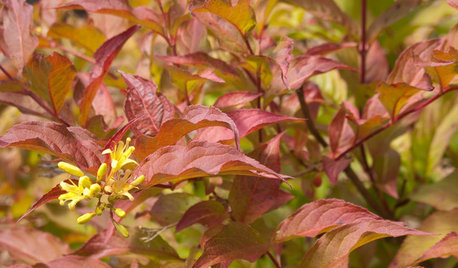
GARDENING GUIDESGreat Design Plant: Northern Bush Honeysuckle, a Bronze Beauty
It helps control erosion and takes sun or shade. The butterflies love it. But the best part of this shrub may be the vivid foliage
Full Story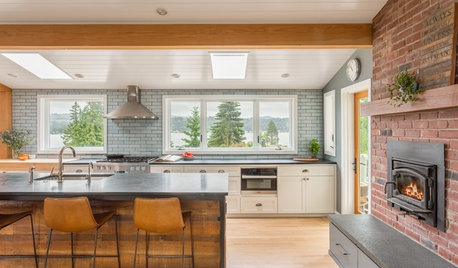
KITCHEN MAKEOVERSKitchen of the Week: Big Windows, Great Views and a Large Island
Knocking down a wall and raising the ceiling allow for a spacious kitchen with stunning lake views
Full Story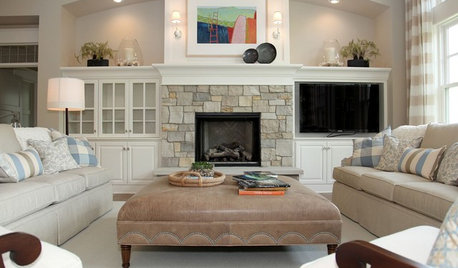
HOUZZ TOURSHouzz Tour: Family-Friendly Coastal Style in Michigan
Three generations share a chic and comfortable home on a lake
Full Story
DECORATING GUIDESDesign Dilemma: I Need Lake House Decor Ideas!
How to Update a Lake House With Wood, Views, and Just Enough Accessories
Full Story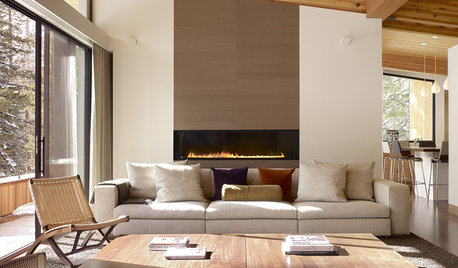
MORE ROOMSGreat Space: New Take on Cabin Chic
Textured wallpaper, linen and wood create a nature-inspired palette for modern Tahoe home
Full Story0
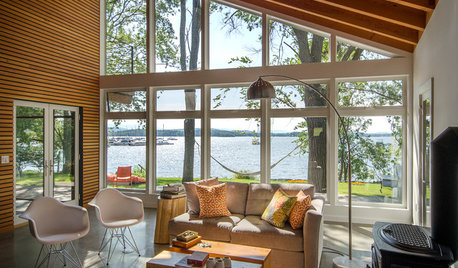
HOUZZ TOURSHouzz Tour: Flexing New Design Muscles on a Vermont Lake
A budding architect gets to build the home of her choice in an idyllic setting — and live there too
Full Story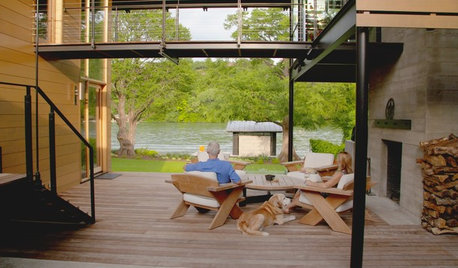
MODERN ARCHITECTUREHouzz TV: This Amazing Lake House Made a Couple’s Dream Come True
Step inside a dream home on Lake Austin, where architecture celebrating gorgeous views has a striking beauty of its own
Full Story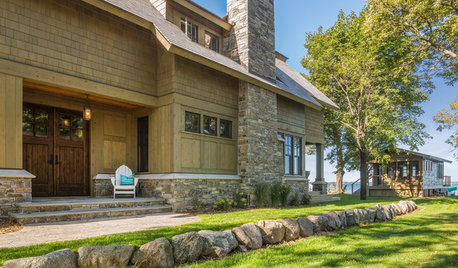
TRADITIONAL HOMESHouzz Tour: New Traditional Home With Lake House Charm
A couple's full-time home on Minnesota's Green Lake offers indoor-outdoor spaces and a comfortable blend of styles
Full Story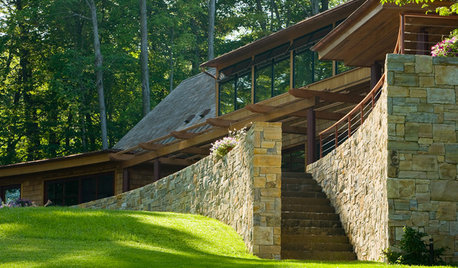
CONTEMPORARY HOMESHouzz Tour: 2 Wings for 3 Generations on a Vermont Lake
An extended family enjoys a spacious waterfront home influenced by farmhouses and Japanese architecture
Full StorySponsored
Zanesville's Most Skilled & Knowledgeable Home Improvement Specialists






reificationofmythOriginal Author